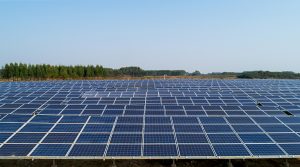India and Taiwan have a unique opportunity to forge a mutually beneficial partnership in the renewable energy sector, particularly in the solar power domain. Taiwan is home to major solar wafer producers like the TSEC Corporation and Green Energy Technology, which could significantly contribute to India’s ambitious renewable energy and battery research and development programs. The partnership also has the potential to create an offshore manufacturing base for Taiwan in India, enabling cheaper imports for quicker domestic deployment.
India aims to achieve 500 GW of installed electricity capacity from non-fossil fuel sources by 2030, with solar power expected to account for over 80 percent of this capacity. However, meeting this target could drive India’s annual solar photovoltaic (PV) import bill from the current $ 7 billion, to around $30 billion, with most imports coming from China. In this regard, India can find a partner in Taiwan to de-risk its sustainable energy supply chains from China’s market-distorting dumping practices.
Similarly, Taiwan aims to install 20 GW of solar PV plant capacity by 2025. However, the target seems elusive, given that the current installed capacity stands at only 5.8 GW. The Taiwanese government has relied on “feed-in” tariffs, which enable businesses and homes to produce their own electricity through renewable sources in a cost-effective manner. The gap between demand for solar and Taiwan’s goals for renewable energy, however, remains massive.
Ironically, in advancing a partnership with Taiwan India can take a leaf out of China’s playbook. The potential for India-Taiwan solar power cooperation can be best understood by examining the Sino-German Energy Partnership. Founded in 2007, this partnership has allowed Germany to share its energy transition lessons with China and raise awareness among Chinese stakeholders about the challenges involved. China has utilized the know-how gained in this partnership to not just dominate the global solar PV market, but also benefit Germany by exporting cheap PV cells.
Germany’s Renewable Energy Sources Act (EEG) of January 2021 has been a game-changer for China’s solar power industry. The EEG’s feed-in tariffs offered global solar manufacturers the opportunity to generate revenue by feeding solar modules to Germany’s renewable energy sector. Simultaneously, German machinery firms such as Centrotherm revolutionized the solar manufacturing landscape by offering turnkey production lines (i.e. supply lines where full products are delivered for intermediate installation).
These “all-in-one” production lines enabled Chinese firms without deep expertise in solar technology to quickly enter the PV module and cell manufacturing market. Subsequently, China reverse-engineered turnkey products obtained from Germany and sold back the PV cells its booming manufacturing base produced, thus powering the renewable energy sector in Germany and the rest of Europe.
While the Sino-German model created a new precedent for energy partnerships, Germany has since faced immense economic challenges due to its inability to replicate China’s cost-effective model. Securitization of trade with China has further exacerbated Germany’s mistrust in the continued exchange of technology and know-how with China in the renewable energy sector.
But in the case of India and Taiwan, there are shared democratic values and a newfound sentiment of cooperation.
In this regard, Indian green energy giants such as Adani Green Energy, which has already established regional project capacity in countries such as Sri Lanka and Bangladesh, can seek technological collaboration with Taiwanese giants such as TSEC Inc. The Indian government can further bat for domestic firms to receive the benefits of Taiwan’s feed-in subsidy plans for establishing a manufacturing base that is ready for both the domestic consumer and for exports to Taiwan. This will, however, require Taiwan to ease restrictions on imports of intermediate solar components from India, and for India to channel R&D and investment into building a robust domestic production ecosystem.
Another area of collaboration for both countries is in the offshore wind sector. India has set a target of achieving 30 GW of offshore wind capacity by 2030 as part of its larger goal of reaching 500 GW of renewable energy. To meet this target, India has identified potential offshore wind zones off the coasts of Gujarat and Tamil Nadu, with an estimated combined potential of over 70 GW. However, implementing these goals requires significant technological expertise and infrastructure development.
This presents a valuable opportunity for collaboration with Taiwan, which has made substantial progress in offshore wind development Through projects like the 300 MW Zhong Neng wind farm. Taiwanese companies have valuable experience in project execution, supply chain management, and grid integration of offshore wind farms. Furthermore, India can learn from Taiwan’s best practices in conducting resource assessments, site selection, and environmental impact studies.
Globally, de-risking from China has become a priority. China now commands over 80 percent share in all manufacturing stages of solar panels, from polysilicon to modules, solidifying its global leadership in solar energy. Taiwan has already restricted imports of solar products from China since 2019, but continues to face challenges in mass-scale adoption of domestic solutions. Here, India can offer cheap labor and production advantages for both intermediate and turnkey products. Further, the fact that the Indian government itself is invested in scaling up technological production under the “Make in India” initiative grants Taiwan a reprieve on the funding front.
In this regard, India and Taiwan have an important opportunity – to create a renewable energy partnership that can act as a new alternative to China’s dominance, without sabotaging domestic and global sustainability goals.
































